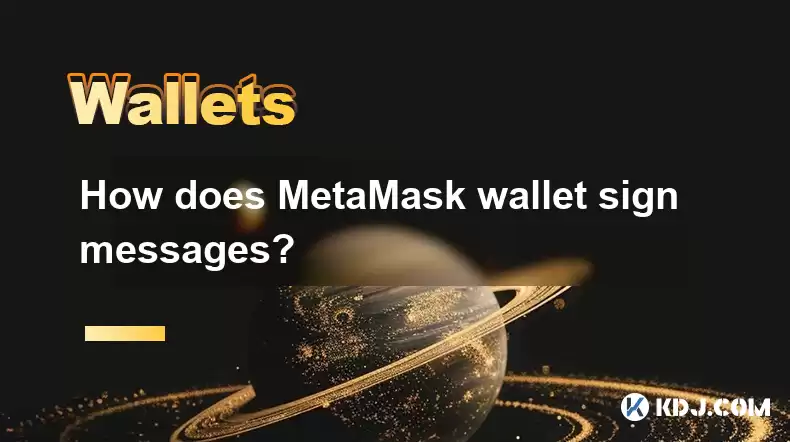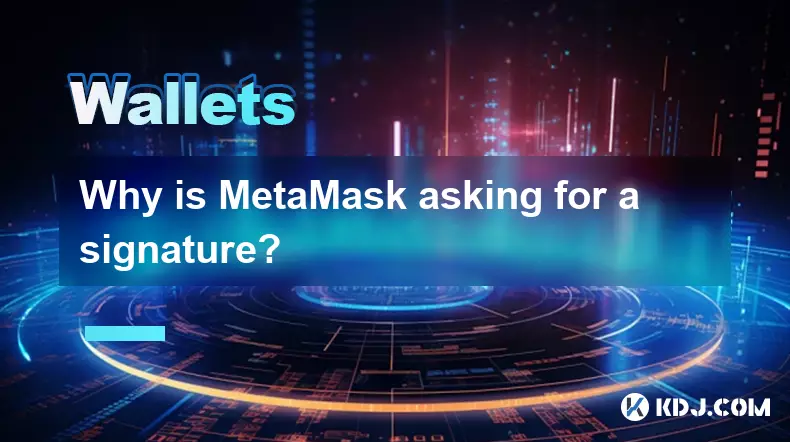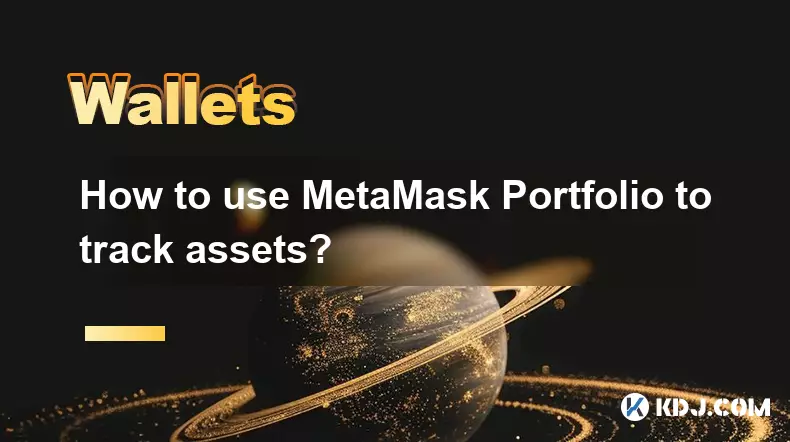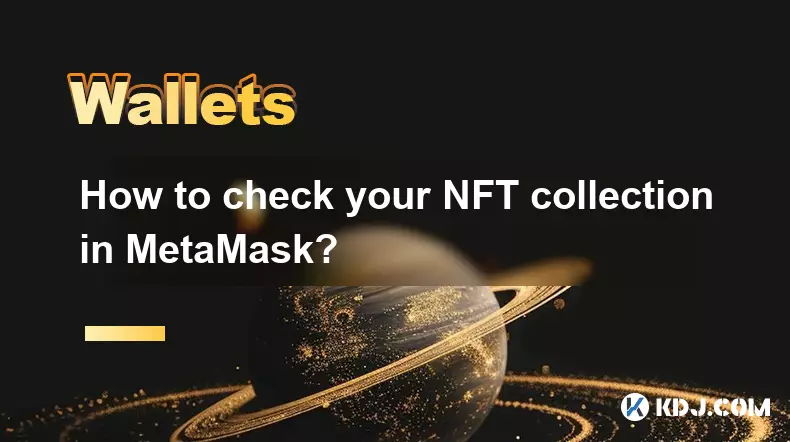-
 bitcoin
bitcoin $102182.982207 USD
-0.92% -
 ethereum
ethereum $3438.744518 USD
0.12% -
 tether
tether $0.999933 USD
0.02% -
 xrp
xrp $2.405093 USD
0.05% -
 bnb
bnb $956.306114 USD
-0.53% -
 solana
solana $153.028851 USD
-1.23% -
 usd-coin
usd-coin $0.999800 USD
-0.03% -
 tron
tron $0.294898 USD
-1.08% -
 dogecoin
dogecoin $0.171428 USD
-0.58% -
 cardano
cardano $0.551186 USD
-1.15% -
 hyperliquid
hyperliquid $38.755878 USD
0.04% -
 chainlink
chainlink $15.298460 USD
-0.05% -
 bitcoin-cash
bitcoin-cash $516.067428 USD
1.68% -
 stellar
stellar $0.280726 USD
-0.42% -
 zcash
zcash $518.919369 USD
18.01%
How does MetaMask wallet sign messages?
MetaMask simplifies message signing with a user-friendly interface, using private keys to create verifiable signatures for identity and transaction authenticity.
Apr 02, 2025 at 06:49 pm

MetaMask, a popular cryptocurrency wallet, offers a secure way for users to sign messages. This process is essential for verifying identity and ensuring the authenticity of transactions within the blockchain ecosystem. When a user signs a message using MetaMask, they are essentially using their private key to create a cryptographic signature. This signature can be verified by anyone with access to the corresponding public key, ensuring that the message indeed came from the owner of that address. The signing process involves several steps, which MetaMask handles seamlessly behind the scenes.
Understanding the Basics of Message Signing
Before diving into how MetaMask signs messages, it's crucial to understand the basics of message signing in the context of cryptocurrencies. Message signing is a cryptographic technique that allows a user to prove ownership of a particular address without revealing their private key. When a message is signed, the private key is used to generate a unique signature. This signature can then be verified using the public key associated with the address. This process is fundamental to many blockchain operations, including transaction authorization and identity verification.
The Role of Private and Public Keys
In the world of cryptocurrencies, every wallet has a pair of keys: a private key and a public key. The private key is kept secret and is used to sign transactions and messages. The public key, on the other hand, is shared openly and is used to verify signatures. When you sign a message with MetaMask, your private key is used to create a signature. Anyone with your public key can then use it to verify that the signature is valid and that the message indeed came from your address.
How MetaMask Handles Message Signing
MetaMask simplifies the process of signing messages by integrating it into its user-friendly interface. When a user wants to sign a message, they can do so directly from the MetaMask extension or mobile app. Here’s how it works:
- Initiate the Signing Process: The user clicks on the 'Sign' button within MetaMask, which prompts them to enter the message they wish to sign.
- Message Hashing: MetaMask hashes the message using a cryptographic hash function, typically SHA-256. This hash is what will be signed, not the original message.
- Signing with Private Key: The hashed message is then signed using the user's private key. This step creates a unique signature that can be verified with the corresponding public key.
- Display and Confirmation: MetaMask displays the signature to the user, who can then copy it and share it as needed. The user must confirm the action to proceed with signing.
Verification of Signed Messages
Once a message has been signed, anyone can verify its authenticity using the signer's public key. This process involves:
- Obtaining the Public Key: The verifier needs access to the public key of the address that supposedly signed the message.
- Hashing the Message: The verifier hashes the original message using the same hash function (e.g., SHA-256) used during signing.
- Verifying the Signature: Using the public key, the verifier checks if the signature matches the hash of the message. If it does, the signature is valid, confirming that the message was indeed signed by the owner of the address.
Security Considerations in Message Signing
While signing messages with MetaMask is straightforward, it's important to consider the security implications. Since the private key is used to sign messages, it's crucial to keep it secure. Here are some security tips:
- Protect Your Private Key: Never share your private key with anyone. MetaMask stores your private key encrypted on your device, but you should always be cautious.
- Use Strong Passwords: Ensure that your MetaMask account is protected with a strong, unique password.
- Beware of Phishing: Be cautious of phishing attempts that may try to trick you into signing malicious messages or revealing your private key.
- Regularly Update MetaMask: Keep your MetaMask software up to date to benefit from the latest security enhancements.
Practical Applications of Message Signing
Message signing with MetaMask has several practical applications within the cryptocurrency ecosystem. Some of these include:
- Identity Verification: Users can prove ownership of an address by signing a message with their private key. This is often used in online forums or social media to verify identity.
- Transaction Authorization: Some decentralized applications (dApps) require users to sign messages to authorize transactions or other actions.
- Digital Signatures: Signed messages can serve as digital signatures for documents or agreements, ensuring their authenticity and integrity.
- Voting and Governance: In decentralized governance systems, users may need to sign messages to cast votes or participate in decision-making processes.
Technical Details of the Signing Process
To delve deeper into the technical aspects of how MetaMask signs messages, it's important to understand the underlying cryptographic algorithms. MetaMask uses the Elliptic Curve Digital Signature Algorithm (ECDSA) for signing messages. ECDSA is widely used in blockchain technologies due to its efficiency and security. Here's a brief overview of the process:
- Key Generation: When a user creates a new wallet, MetaMask generates a pair of keys using the secp256k1 elliptic curve.
- Message Hashing: The message to be signed is hashed using SHA-256, producing a fixed-size hash.
- Signature Generation: Using the private key and the hash, MetaMask generates a signature using ECDSA. This signature consists of two components, typically referred to as r and s.
- Signature Verification: The signature can be verified using the public key and the original message hash. If the verification succeeds, it confirms the authenticity of the signature.
User Experience with MetaMask Message Signing
MetaMask prioritizes user experience by making the message signing process as intuitive as possible. Users are guided through each step with clear instructions and visual cues. Here’s what the process looks like from a user’s perspective:
- Accessing the Signing Feature: Users can access the signing feature from the MetaMask interface, typically found under the 'Sign' or 'Message' section.
- Entering the Message: The user enters the message they wish to sign into a provided text field.
- Review and Confirmation: Before signing, MetaMask displays the message and asks for user confirmation. This step ensures that users are aware of what they are signing.
- Signature Display: Once signed, MetaMask displays the signature in a readable format, allowing users to easily copy and share it.
Integration with Decentralized Applications (dApps)
MetaMask’s message signing capabilities are particularly useful for interacting with decentralized applications (dApps). Many dApps require users to sign messages to authenticate their identity or authorize actions. Here’s how MetaMask integrates with dApps for message signing:
- dApp Requests: When a dApp requires a user to sign a message, it sends a request to MetaMask.
- User Interaction: MetaMask prompts the user to review and sign the message, ensuring they are aware of the action they are taking.
- Secure Signing: The signing process is handled securely within MetaMask, using the user’s private key.
- Result Communication: Once signed, the signature is sent back to the dApp, which can then verify it and proceed with the requested action.
Common Use Cases for Message Signing
Message signing with MetaMask is used in various scenarios within the cryptocurrency ecosystem. Some common use cases include:
- Verification of Ownership: Users can prove they own a particular address by signing a message with their private key.
- Authorization of Transactions: Some platforms require users to sign messages to authorize specific transactions or actions.
- Participation in Governance: In decentralized governance systems, users may need to sign messages to vote or participate in decision-making processes.
- Digital Agreements: Signed messages can serve as digital signatures for agreements or contracts, ensuring their authenticity and integrity.
Troubleshooting Common Issues
While MetaMask makes message signing straightforward, users may encounter some issues. Here are some common problems and their solutions:
- Signature Mismatch: If a signature fails to verify, ensure that the original message and the public key used for verification are correct.
- Private Key Access: If MetaMask prompts for a private key, ensure you are using the official MetaMask software and not a phishing site.
- Outdated Software: Ensure your MetaMask software is up to date to benefit from the latest security and functionality improvements.
- Network Issues: Sometimes, network connectivity problems can affect the signing process. Check your internet connection and try again.
Future Developments and Enhancements
As the cryptocurrency ecosystem evolves, so too will the capabilities of MetaMask. Future enhancements may include:
- Enhanced Security Features: Improved security measures to protect private keys and signing processes.
- Integration with More dApps: Broader integration with decentralized applications, making message signing even more seamless.
- User Interface Improvements: Continued enhancements to the user interface to make the signing process even more intuitive.
- Support for New Cryptographic Algorithms: Potential support for new or updated cryptographic algorithms to enhance security and efficiency.
Common Questions Related to MetaMask Wallet Message Signing
Q1: What is message signing in the context of MetaMask?A1: Message signing in MetaMask involves using your private key to create a cryptographic signature for a message. This signature can be verified by anyone with your public key, confirming that the message came from your address.
Q2: How does MetaMask ensure the security of message signing?A2: MetaMask ensures the security of message signing by storing your private key encrypted on your device and requiring user confirmation before signing. It also uses established cryptographic algorithms like ECDSA for secure signing.
Q3: Can I sign messages with MetaMask on both desktop and mobile?A3: Yes, MetaMask supports message signing on both its desktop extension and mobile app, providing a consistent user experience across platforms.
Q4: What are some practical uses of message signing with MetaMask?A4: Practical uses include identity verification, transaction authorization, digital signatures for agreements, and participation in decentralized governance systems.
Q5: What should I do if I encounter issues with message signing in MetaMask?A5: If you encounter issues, ensure you are using the latest version of MetaMask, check your internet connection, and verify that the message and public key used for verification are correct. If problems persist, consider reaching out to MetaMask support.
Disclaimer:info@kdj.com
The information provided is not trading advice. kdj.com does not assume any responsibility for any investments made based on the information provided in this article. Cryptocurrencies are highly volatile and it is highly recommended that you invest with caution after thorough research!
If you believe that the content used on this website infringes your copyright, please contact us immediately (info@kdj.com) and we will delete it promptly.
- Milk Mocha Meme Coin Presale Frenzy: HUGS Steals Hearts and Crypto
- 2025-11-14 02:50:01
- Aster Price, Market Strength, and Future Outlook: A Bullish Beacon?
- 2025-11-14 03:40:02
- eBay 50p Coin Frenzy: Are You Sitting on a Hidden Fortune?
- 2025-11-14 03:22:21
- Kamirai: Blazing a Trail in DeFi Gaming with TGE Success
- 2025-11-14 03:22:21
- Trevor Shane, Coin, Cryptocurrency: A Deep Dive into Digital Finance
- 2025-11-14 03:40:02
- Decoding Crypto Trends: XRP's 'Digital Gold' Ascent, Dogecoin's Whale Accumulation, and BFX's Presale Surge
- 2025-11-14 04:00:02
Related knowledge

Why is MetaMask asking for a signature?
Nov 10,2025 at 06:19pm
Understanding Signature Requests in MetaMaskMetaMask frequently prompts users to sign messages or transactions as part of its standard operation. Thes...

How to use MetaMask Portfolio to track assets?
Nov 08,2025 at 05:40am
Getting Started with MetaMask Portfolio1. Download and install the MetaMask mobile app from the App Store or Google Play. Open the app and select 'Imp...

MetaMask not popping up: how to fix this issue?
Nov 10,2025 at 05:59am
Understanding the MetaMask Pop-Up Issue1. MetaMask is one of the most widely used cryptocurrency wallets, especially for interacting with decentralize...

How to send ETH from Binance to MetaMask?
Nov 10,2025 at 04:40am
Sending ETH from Binance to MetaMask: A Step-by-Step GuideTransferring Ethereum (ETH) from your Binance account to your MetaMask wallet is a common op...

How to check your NFT collection in MetaMask?
Nov 06,2025 at 08:20pm
Accessing Your NFTs in MetaMask Wallet1. Open the MetaMask browser extension or mobile app and ensure you are logged into your wallet account. Once in...

Why is the MetaMask swap feature failing?
Nov 06,2025 at 09:20pm
Understanding MetaMask Swap FailuresMetaMask, one of the most widely used cryptocurrency wallets, enables users to swap tokens directly within the int...

Why is MetaMask asking for a signature?
Nov 10,2025 at 06:19pm
Understanding Signature Requests in MetaMaskMetaMask frequently prompts users to sign messages or transactions as part of its standard operation. Thes...

How to use MetaMask Portfolio to track assets?
Nov 08,2025 at 05:40am
Getting Started with MetaMask Portfolio1. Download and install the MetaMask mobile app from the App Store or Google Play. Open the app and select 'Imp...

MetaMask not popping up: how to fix this issue?
Nov 10,2025 at 05:59am
Understanding the MetaMask Pop-Up Issue1. MetaMask is one of the most widely used cryptocurrency wallets, especially for interacting with decentralize...

How to send ETH from Binance to MetaMask?
Nov 10,2025 at 04:40am
Sending ETH from Binance to MetaMask: A Step-by-Step GuideTransferring Ethereum (ETH) from your Binance account to your MetaMask wallet is a common op...

How to check your NFT collection in MetaMask?
Nov 06,2025 at 08:20pm
Accessing Your NFTs in MetaMask Wallet1. Open the MetaMask browser extension or mobile app and ensure you are logged into your wallet account. Once in...

Why is the MetaMask swap feature failing?
Nov 06,2025 at 09:20pm
Understanding MetaMask Swap FailuresMetaMask, one of the most widely used cryptocurrency wallets, enables users to swap tokens directly within the int...
See all articles










































































